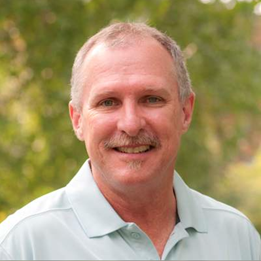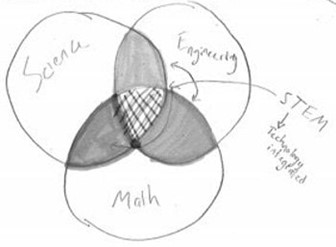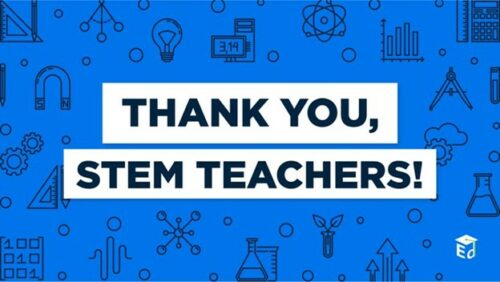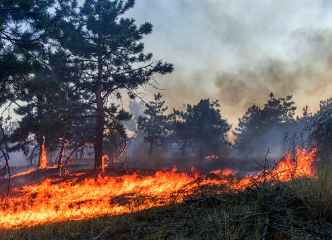
STEM STRATEGIES
For the past decade, PLT has featured a “STEM Strategies” column in our Branch Newsletter. First launched in 2013, PLT had the opportunity to partner with Dr. Kris Irwin to author a total of 30 STEM Strategies that supplement activities within various PLT curriculum guides, including the Explore Your Environment: K-8 Activity Guide. Dr. Irwin serves as the Associate Dean for Outreach and Co-Director for Environmental Education Certificate Program with the Warnell School of Forestry & Natural Resources at the University of Georgia. His expertise with integrating technology into environmental education is deep-rooted, as are his contributions to the Project Learning Tree program. As Dr. Irwin plans for his retirement in early 2024, we are excited to share his favorite STEM Strategies from over the years.
A STEM STRUCTURE
 It was Dr. Irwin who first devised the original template for PLT’s STEM Strategies. All articles begin with an Essential Question and at least one corresponding, student-driven Task.
It was Dr. Irwin who first devised the original template for PLT’s STEM Strategies. All articles begin with an Essential Question and at least one corresponding, student-driven Task.
Essential Questions are overarching or topical questions that guide lesson plans or other formalized instruction. Some might argue that Essential Questions were one of the driving factors that led to the popular phenomenon-based science inquiry of today. Many Essential Questions are good examples of questions grounded in phenomena that can be generated by students themselves in the self-directed learning of today.
Tasks operate on the assumption that new expertise is built through experience. Tasks expose learners to situations where they can safely practice the content they are learning and collaboratively nurture their own ability to solve problems with new skills.
All PLT STEM Strategies are also correlated to the Next Generation Science Standards. This framework provides context for why the Essential Questions and Tasks fit into larger nationwide learning mandates for science instruction. Be sure to check out PLT’s robust, 50-page toolkit that connects all Explore Your Environment activities to NGSS.
Finally, all PLT STEM Strategies investigate the individual STEM components of Science, Technology, Engineering, and Math in support of a certain topic. The articles provide extended investigation suggestions that support concepts covered in the PLT activity at hand. PLT acknowledges that this approach to STEM instruction is individualized, as opposed to integrated across problem-solving strategies or discipline areas. PLT’s goal, however, remains to get more educators engaged in thinking about cross-curricular connections and bolstering all four STEM subject areas using environmental education.
THE STEM CONTINUUM
 Research published by the Journal of Science Teacher Education (2017) describes an evolution of STEM education. Research shows that K-12 teachers use no less than eight mental models to interpret and teach STEM, representing a continuum. On one extreme exists a shallow understanding of STEM that includes the four separate disciplines, while the other extreme touts a more in-depth comprehension described as integrated STEM, where all the fields connect in complex relationships. As with any continuum, there can be many steps in between.
Research published by the Journal of Science Teacher Education (2017) describes an evolution of STEM education. Research shows that K-12 teachers use no less than eight mental models to interpret and teach STEM, representing a continuum. On one extreme exists a shallow understanding of STEM that includes the four separate disciplines, while the other extreme touts a more in-depth comprehension described as integrated STEM, where all the fields connect in complex relationships. As with any continuum, there can be many steps in between.
Emily Dare is an Associate Professor of Science Education at Florida International University, and her research efforts are focused on K-12 STEM education. She describes the integrated STEM teaching model as “a super Venn diagram where teachers decide which field to emphasize depending on the class, lesson content and students” (see image to right). This perspective represents the ultimate goal for teachers and other educators shepherding the skills of today’s youth. Project Learning Tree, and other professional development providers, can help educators move from one end of the STEM continuum to the other.
BEST OF STEM
We were able to ask Dr. Irwin about his favorite PLT STEM Strategies to date. He was delighted to share the following “Best of STEM” Branch articles from the past decade and what he likes most about each. According to Dr. Irwin, “The three activities below embrace the objectives of environmental education, helping move an individual from Awareness to Action (AKASA). They also highlight the importance of place-based learning, having fun, being challenged, learning life skills, and appreciating our natural environments.”
Trees as Habitats (2017) – Engage students in STEM as they explore why snags (standing dead trees) make excellent habitats for a whole host of living communities – including birds, mammals, insects, fungi, amphibians, and reptiles.
S – Gives the word “snag” a positive attribute. I want readers to look at a dead tree as a home.
T – Invites students to learn about the climate. I feel we need more place-based learning experiences and this does it.
E – Allows for creative ideas to flow and to learn a new software skill.
M – Encourages action to help birds. I also like that learning how to calculate population growth rates put the learning in context.
Living With Fire (2017) – Use STEM to explore the BIG difference between a wildfire – an unplanned event which often results in landscape devastation – and a prescribed fire – one that is ignited with the purpose of reducing the risk of wildfire while improving forest health and wildlife habitat. Students learn how fire can be beneficial to a forest landscape when it is planned and managed.
S – Provides basic fire knowledge for their safety, and the safety of the forest.
T – Involves the family. Not only for safety reasons, but also in the creation of suitable fire-wise landscaping.
E – Is challenging and allows for creativity. Fun and competitive too.
M – Teaches probability and prediction, skills that are necessary in life. Learning how to think!
Sounds Around (2020) – Can you imagine not being able to hear a bubbling brook or songbird call? Over 600,000 people in the United States are not able to hear these sounds – and more – because of hearing impairments. Use STEM, coupled with your sense of hearing to learn about the natural wonders of our feathered friends ahead of World Migratory Bird Day, held in May each year.
S – Engage students as citizen scientists and encourage taking part in bird counts (action).
T – The technology helps teach birding by ear.
E – Creating a tool that demonstrates why owl wings are silent in flight is just cool. They are on their way to learning how to be great educators!
M – Learning to construct and interpret graphs is a life skill and they learn about bird populations in their local area (place-based knowledge).
AN INTEGRATED THANK YOU!
 Through STEM, teachers help students understand the application of what they learn. Through experience and practice, youth start to see a typical task as a means to apply scientific thinking, implement a new tool or technology, design a solution, or interpret the experience through numeracy. This integration helps prepare students for the dynamic needs of a sustainable future.
Through STEM, teachers help students understand the application of what they learn. Through experience and practice, youth start to see a typical task as a means to apply scientific thinking, implement a new tool or technology, design a solution, or interpret the experience through numeracy. This integration helps prepare students for the dynamic needs of a sustainable future.
Thank you, Dr. Kris Irwin, for your amazing contributions to STEM, PLT, and environmental education. Three cheers for all STEM educators across the country…and the world!



